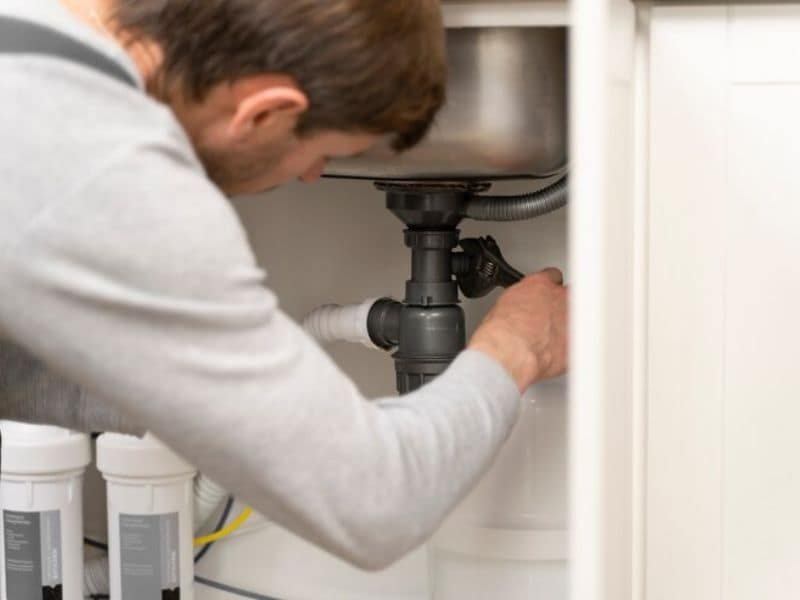You rely on your water heater every day—for hot showers, dishwashing, laundry, and more. But how often do you give it the attention it deserves? One of the most important yet overlooked tasks in water heater maintenance is flushing the tank. If you’ve never done it, you’re not alone—but skipping this task could cost you hundreds of dollars in repairs or replacements down the line.
Flushing a water heater removes sediment buildups, improves efficiency, and expands the lifetime of the unit. Without flushing regularly, the mineral accumulates on the floor of the deposit tank, causing noise operations, poor heating performance and premature tank failure.
So, how many times should you flush your water heater? The answer depends on many factors, including the type of water in your area and how much hot water of your household water. In this guide, we will break it all so that you can keep your system running smoothly and avoid expensive breakdown.

What Flushing a Water Heater Means
Purpose of Flushing
Flushing a water heater means draining all the water from the tank to remove built-up sediment and minerals that naturally accumulate over time. This debris comes mostly from:
- Hard water (high in calcium and magnesium)
- Corroded anode rods
- Small rust flakes or debris from the plumbing system
When sediment builds up, it settles at the bottom of the tank and creates a barrier between the burner (in gas models) or heating elements (in electric models) and the water. This causes the system to work harder, use more energy, and heat less efficiently.
Flushing clears out that buildup, allowing your water heater to run cleaner and more effectively.
What Happens If You Don’t Flush It
If you ignore flushing, here’s what can happen over time:
- Tank seems to be banging or bangs like water boils through sediment
- Clogged drain valves
- Discolored water, especially when turning on hot taps
- Reduced efficiency and higher energy bills
- Shortened lifespan of the water heater (by years!)
- Complete failure due to overheating or rust-through at the bottom
Simply put, flushing is preventive maintenance that helps you avoid expensive plumbing calls and the hassle of cold water surprises.
READ MORE: Free Water Heater Disposal Near Me
Recommended Flushing Frequency
General Guidelines from Manufacturers
Most water heater manufacturers—including Rheem, A.O. Smith, Bradford White, and others—recommend flushing your water heater at least once a year. This schedule applies to both tank-style electric and gas water heaters.
Some even suggest flushing every 6 months if:
- You have very hard water
- Your heater is under heavy use
- Your household includes more than 4 people
Sticking to this schedule:
- Extends your unit’s life by 3–5 years
- Keeps your warranty valid in some cases
- Ensures hot water stays clean and consistent
Different Recommendations for Gas vs Electric Heaters
While the basic flushing process is similar, the urgency of flushing may vary:
- Gas water heaters: More sensitive to sediment because heat comes from the bottom burner. Flushing every 6–12 months is ideal.
- Electric water heaters: Sediment can bury heating elements, leading to burnout. Flushing annually is usually sufficient unless your water is very hard.
Tankless water heaters also benefit from maintenance but require descaling, not flushing—so the maintenance method differs.
Factors That Influence Flushing Frequency
Water Hardness and Sediment Buildup
Water hardness is #1 factor that determines how fast sediment is made. If your water supply contains high levels of calcium and magnesium (ie, “hard water”), your heater will collect the scale rapidly. Here is a simple guide:
| Water Hardness Level | Flushing Frequency |
| Soft (0–60 ppm) | Once every 12–18 months |
| Moderate (61–120 ppm) | Once a year |
| Hard (121–180 ppm) | Every 6–9 months |
| Very Hard (180+ ppm) | Every 3–6 months |
You can test your water hardness using a home water test kit or contact your local utility for a water quality report.
Usage Patterns and Household Size
The more hot water your home uses, the faster sediment builds up. Flushing frequency may need to increase if:
- You have a large family or frequent guests
- You use hot water for laundry, dishwashing, showers multiple times daily
- You live in a region with year-round water heater usage
A household of 1–2 people with light usage may only need annual flushing. But homes with 4+ occupants often benefit from twice-yearly maintenance.
READ MORE: Can a Water Heater Explode If Turned Off?
Signs Your Water Heater Needs Flushing
Noisy Operation and Rumbling
If your water heater is popping, rumming or bang, it is usually caused by small pockets of water due to sediment buildup. When that water becomes hot, it bursts through the sedimentary layer, produces noise.
This is an important sign that your water heater needs to be flushed immediately. Ignoring it can result in results:
- Overheating
- Element burnout (in electric models)
- Structural damage to the tank
Discolored or Smelly Water
If your warm water rushes, clouds or rotten eggs, flushing the tank can often solve the problem. These symptoms indicate:
- Bacteria buildup inside the tank
- Corroded anode rods
- Accumulated debris that’s being stirred into the water
Flushing helps remove this gunk, restore clean water, and improve overall hygiene.
How to Flush a Water Heater Step-by-Step
Safety First
Before you begin, make sure to:
- Turn off power or gas supply to the water heater
- Allow the water to cool for 1–2 hours (especially for electric models to avoid damage)
- Have a hose and bucket ready to drain the tank
Step-by-Step Guide
- Turn off the water supply to the heater (usually located at the cold water inlet on top).
- Connect a garden hose to the drain valve at the bottom of the tank.
- Run the hose to a safe drainage location—outdoors or into a large bucket.
- Open the hot water tap at a nearby sink to relieve pressure and allow air into the system.
- Open the drain valve and let the tank empty completely.
- (Optional) Once drained, open the cold water valve briefly to stir and flush remaining sediment.
- Close the drain valve and remove the hose.
- Turn the water supply back on and let the tank refill fully.
- Only once the tank is full, turn the power or gas supply back on.
Let the water run for 5–10 minutes to check for clarity, and ensure there are no leaks around the drain valve.
Pro Tip: If sediment blocks the drain valve, you may need to use a wet/dry vac or gently poke the opening with a small screwdriver (with caution).
READ MORE: How to Install Heating Element in Water Heater
Tankless Water Heater Maintenance
The tankless water heater does not have a storage tank, but they suffer from scale buildups, especially in hard water areas. Instead of flushing the tank, you have to land the unit using a special vinegar solution or a decaling kit.
Most manufacturers recommend descaling once a year to keep heat exchanges clean and efficient. Usually involve the stages:
- Turning off power and water
- Connecting a pump and hose system
- Circulating the descaling solution
- Rinsing the unit thoroughly
Always follow your specific brand’s instructions to avoid damaging internal components.
Professional Water Heater Flushing: Is It Worth It?
If you’re not comfortable doing it yourself—or your heater hasn’t been flushed in years—it may be worth hiring a licensed plumber for a full system flush.
Professional services usually include:
- Full tank draining and flushing
- Anode rod inspection
- Temperature and pressure valve testing
- Leak checks and diagnostics
Cost: $100–$200 depending on your location
While DIY is cheaper, a professional flush ensures thorough cleaning and can help catch early signs of wear or failure—saving you money in the long run.
Flushing Myths and Mistakes to Avoid
1. You Only Need to Flush When There’s a Problem
Wrong! Waiting for a problem means the sediment has already built up. Flushing is preventive, not reactive.
2. You Can’t Flush an Old Water Heater
False. Older units benefit the most from flushing—but you may need to be cautious with rusty or corroded drain valves.
3. You Must Use Chemicals
Nope. In most cases, plain water is enough. For heavy sediment or scale, a vinegar rinse can be added—but chemicals aren’t usually required.
4. All Water Heaters Need the Same Schedule
Not true. Your flushing needs depend on water quality, usage, and heater type. Always tailor your schedule accordingly.
READ MORE: Why Is My Hot Water Heater Not Working?
Conclusion
Flushing your water heater isn’t just a good idea—it’s essential. Whether you’re trying to extend the life of your unit, lower energy bills, or maintain clean water, regular flushing is a simple task with big benefits.
Most household owners should flush their water heaters once a year or every 6 months, if they have hard water or busy home. This is an easy weekend DIY project that can prevent expensive breakdown, expand your heater life, and ensure that your hot water remains fresh and efficient.
If you have never flushed your water heater before, now is the right time to start. And if you are not convinced of doing it yourself, call a professional for peace of mind.
FAQs
1. How do I know if my water heater needs flushing?
If it makes noise, produces rusty or smelly water, or heats water slower than usual—it likely needs a flush.
2. Can flushing a water heater damage it?
Only if done incorrectly. Avoid using sharp tools or over-tightening fittings. Otherwise, it’s completely safe.
3. What happens if I never flush my water heater?
Sediment will build up, reducing efficiency and potentially leading to tank failure and costly repairs.
4. Does flushing improve water quality?
Yes. It removes rust, bacteria and scale buildups that can affect the taste, smell and clarity of water.
5. How long does it take to flush a water heater?
Typically 30–45 minutes, depending on tank size and how long it takes to drain and refill.

